

India 1988-89
Page 2
 The
Taj Mahal, one of the most amazing structures ever built by man. The
Taj Mahal, one of the most amazing structures ever built by man.Mughal Emperor Shah Jahan was grief-stricken when his second wife, Mumtaz Mahal, died giving birth. He wanted to construct the most amazing tomb as a symbol of his love for his departed wife. As Shah Jahan ruled during the Mughal's greatest prosperity, he had the financial means to carry out his inspiration, and began constructing the mausoleum in 1631. The marble dome is about the same height as the base of the building, approximately 35 meters. Topping the dome is a gilded spire, which was made of gold until the early 1800s, and is now made of bronze. The spire is a blend of Persian and Hindu elements. It is, for instance, topped by a moon, a typical Islamic motif, although the points of the crescent moon point upwards. However, the spire point and the moon's points combine to form a trident, associated with one of the Hindu traditional symbols of Shiva.
|
 Another
view of the greatest tribute to a woman ever built. The Taj Mahal is
easily one of the most celebrated and recognized buildings in the world.
Visiting it only enhances one's appreciation of the artistry and detail that
exists in every corner of the structure. Another
view of the greatest tribute to a woman ever built. The Taj Mahal is
easily one of the most celebrated and recognized buildings in the world.
Visiting it only enhances one's appreciation of the artistry and detail that
exists in every corner of the structure.
|
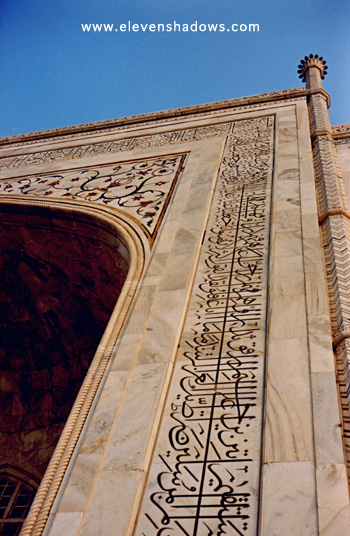 Throughout
the Taj Mahal complex, passages from the Qur'an are used as decorative
elements. The calligraphy is a florid and practically illegible thuluth
script, created by the resident Mughal court's Persian calligrapher, Amanat
Khan who signed several of the panels. As one enters through the Taj Mahal
Gate, the calligraphy reads "O Soul, thou art at rest. Return to the Lord at
peace with Him, and He at peace with you." Throughout
the Taj Mahal complex, passages from the Qur'an are used as decorative
elements. The calligraphy is a florid and practically illegible thuluth
script, created by the resident Mughal court's Persian calligrapher, Amanat
Khan who signed several of the panels. As one enters through the Taj Mahal
Gate, the calligraphy reads "O Soul, thou art at rest. Return to the Lord at
peace with Him, and He at peace with you." |
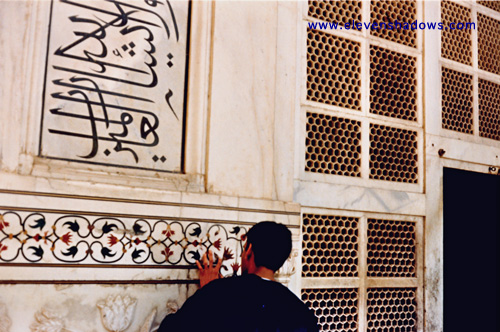 Tom
examines the detail near the entrance to the tomb. The entire
structure has exquisite designs and calligraphy composed of semi-precious
stones, such as agate, jade, onyx, and turquoise. Tom
examines the detail near the entrance to the tomb. The entire
structure has exquisite designs and calligraphy composed of semi-precious
stones, such as agate, jade, onyx, and turquoise. |
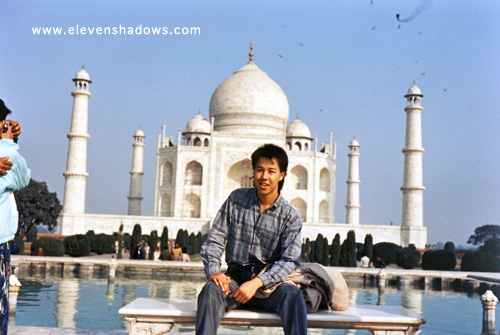 Resting
by the reflective pool of the Taj Mahal in Agra. Resting
by the reflective pool of the Taj Mahal in Agra. |
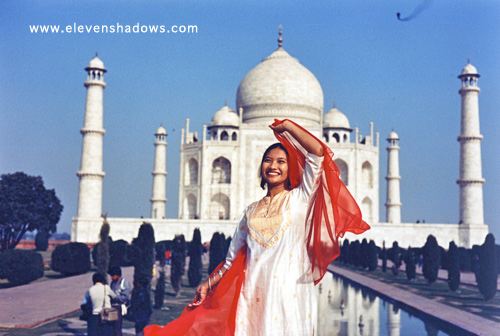 Taj
Mahal, Agra, India. Taj
Mahal, Agra, India. |
 |
 Mr.
C, Papu, Smriti, Oran, Sringi, Vena, Tom, and the driver, whose name has
disappeared into the cobwebs of my mind. Mr.
C, Papu, Smriti, Oran, Sringi, Vena, Tom, and the driver, whose name has
disappeared into the cobwebs of my mind.August 2009: Shringi contacted me and mentioned that the driver's name is Revti, and still remembers me well. He still drives cars and now owns his own repair shop. |
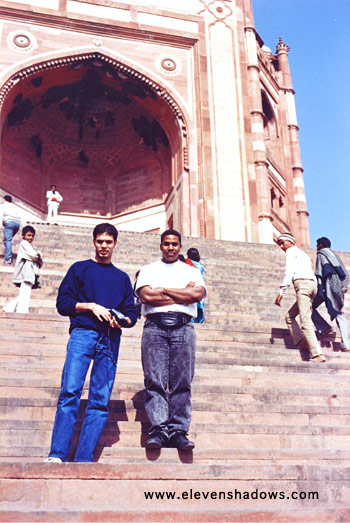 Fatehpur
Sikri (The City of Victory) was the capital of the Mughal Empire, although
only for ten years. The complex of monuments and temples includes one
of the largest mosques in India, the Jama Masjid. Fatehpur
Sikri (The City of Victory) was the capital of the Mughal Empire, although
only for ten years. The complex of monuments and temples includes one
of the largest mosques in India, the Jama Masjid.
Tom and Oran standing on the steps of the highest gate in India (and one of the biggest in the world), built in 1602 by Akbar to commemorate his victory over India. |
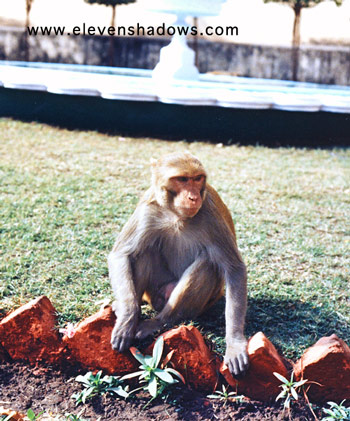 On
January 4, we continued on to the Jaipur City Palace, where the current king
of Jaipur currently resides. On
January 4, we continued on to the Jaipur City Palace, where the current king
of Jaipur currently resides.I revisited the City Palace and Jaipur on a 2005 trip to India. |
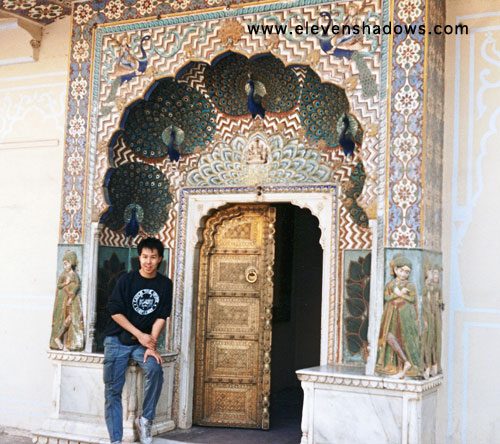 City
Palace in Jaipur - Court of the Beloved, with its exquisitely painted doors,
like the famous peacock doors with its sculpted peacocks and carvings. City
Palace in Jaipur - Court of the Beloved, with its exquisitely painted doors,
like the famous peacock doors with its sculpted peacocks and carvings.There's some photos of other doors in the courtyard from my 2005 trip to India. The Citiy Palace is located in Jaipur, the capital of Rajasthan, and is a blend of local Rajasthan and Mughal architecture. Returning to explore Rajasthan further in 2005, I found this to be the most colorful region of India...and India is the most colorful country I've ever seen.
|
 After
visiting the City Palace in Jaipur and having amazing dal at one of the
restaurants, we returned back to New Delhi. After
visiting the City Palace in Jaipur and having amazing dal at one of the
restaurants, we returned back to New Delhi.
I walked over to the nearby Birla Mandir, where Tom's parents got married. |
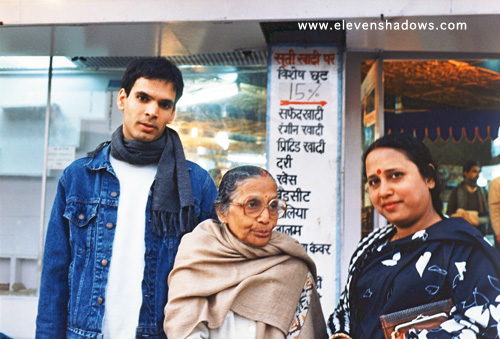 Tom,
Grandma, and Mashi (Tom's aunt) shopping at the Bengal Emporium in New
Delhi. Tom,
Grandma, and Mashi (Tom's aunt) shopping at the Bengal Emporium in New
Delhi. |
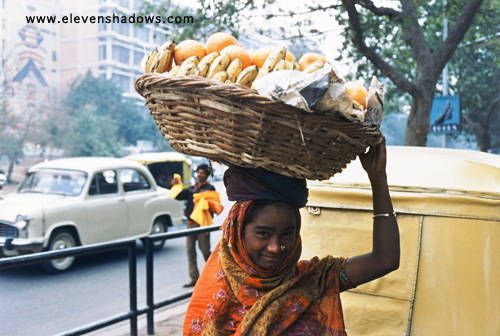 Another
woman selling fruit by Janpath Market in New Delhi. India's fruit is
delicious and flavorful, far better than the bland, tasteless fruit I
usually must settle for in the United States. Another
woman selling fruit by Janpath Market in New Delhi. India's fruit is
delicious and flavorful, far better than the bland, tasteless fruit I
usually must settle for in the United States. |
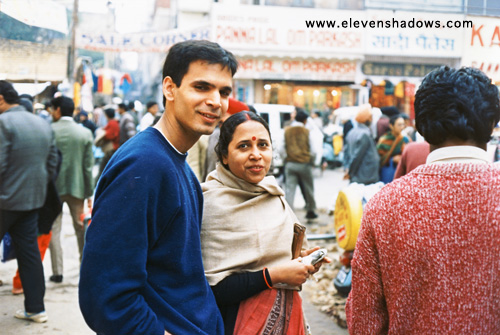 Tom
and Mashi at the Ajmal Khan Market in New Delhi. Tom
and Mashi at the Ajmal Khan Market in New Delhi. |
India 1988-1989
Page 2